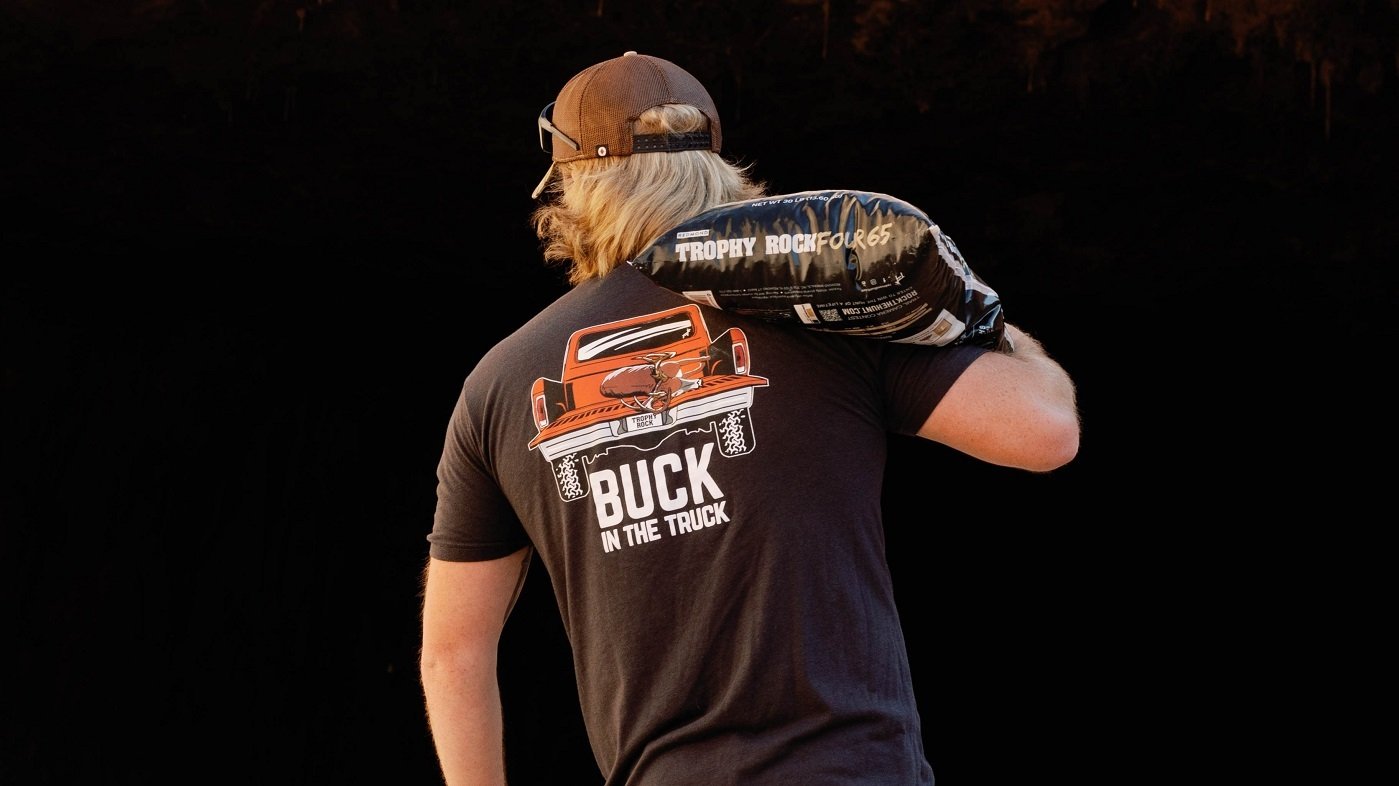Redmond Hunt Blog
How to Stay Warm Hunting & Prevent Hypothermia & Frostbite
Redmond Hunt December 9, 2022
Plan to go winter hunting? Learn how to prevent hypothermia and frostbite, stay warm and layer for cold weather with the right late season hunting clothes.
In this article, Redmond Hunt team member, Skylyn Christensen, shares helpful tips on the best ways to stay warm while hunting and recognizing/treating hypothermia and frostbite. Sky is an outdoor videographer and avid hunter with years of experience hunting in frigid temperatures from tree stands and high backcountries.
A recent elk hunt in the mountains of Colorado and a close encounter with hypothermia hammered home the dangers we hunters face heading out on late-season hunts. Being equipped with the right gear and some basic skills helped me and my hunting buddies avert a potentially life-threatening situation.
Knowing some winter first-aid and how to dress for extreme cold can also help you, your family, and friends stay safe venturing out this winter season. So let's get you up to speed on how to recognize and treat the symptoms of frostbite and hypothermia—then get tips on the best clothing, layering system, and gear for cold-weather hunting.
Quick Content Guide
- Story: High-country hunting and hypothermia
- Hypothermia symptoms and treatment
- Frostbite symptoms and treatment
- Best layering system and hunting clothing for cold weather
- Cold-weather hunting gear and add-ons to keep you warm
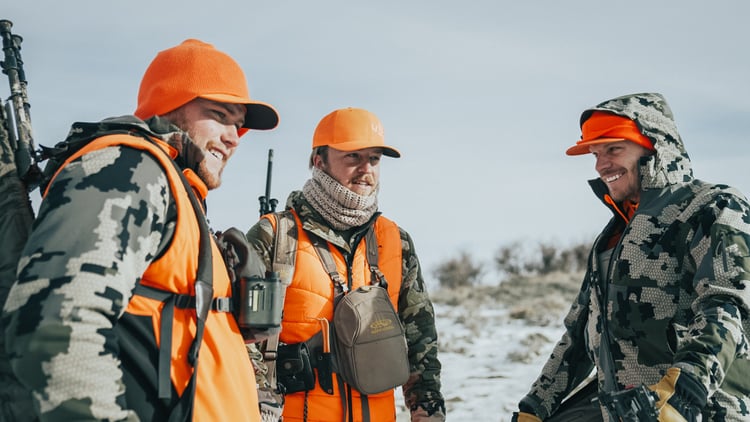
A High-Country Elk Hunt and Hypothermia Scare
During mid-November, two friends and I set off into the mountains of Colorado to hunt elk. The week prior, ten inches of snow had fallen in the area and temperatures were sitting in the 20s during the day and diving to single digits at night. We were layered with good clothing and gear, however, and felt prepared to navigate the terrain and temps while tagging a couple of nice bulls.
On day three, Chase, Kyle, and I tracked a herd at the bottom of a canyon and made a game plan to come in on them from the top. Kyle harvested a nice bull, and because Chase still had an unfilled tag, he and I headed after the herd again. We found them bedded down in some burned pines and Chase sighted in on a five-point at 350 yards. He got a shot off but wasn’t sure of the placement, and the bull ran two canyons over and out of sight.
We tracked it a little further, and then at that point, split up. I went back to help Kyle process his elk, and Chase went after the bull. He didn’t have much gear, as he’d dropped his pack at the previous elk’s harvest site and brought only his gun—a rushed and, we'd soon learn, bad decision.
It took Kyle and me two and a half hours to process the elk, and by that point, it was well past dark, temperatures had dipped into the teens, and we’d not seen Chase for several hours. While Kyle headed for the truck with the quartered elk, I grabbed Chase's pack and made my way back to where we'd split up.
I finally found him navigating a rugged cliff, and he hollered to wait for him at the bottom. I immediately began building a fire as he was showing classic signs of hypothermia: extreme exhaustion, not shivering, moving slowly, and becoming disoriented. By the time he made it down, he was coughing hard, throwing up, and severely dehydrated.
We added more layers of insulation to Chase's core and hands with the extra gear from his pack. Then slowly got him hydrated and warm enough to make it back to the truck for additional help. It was a scary situation—one I’m glad we all made it out of safely—and reinforced the importance of hunting smart and being prepared with the right gear in winter.
Risk of Hypothermia and Frostbite in Hunters
Our bodies continuously produce heat to keep us alive, but in cold temps, we can lose more heat than our bodies are able to generate. Hunters are particularly at risk. We routinely take on high elevations and prolonged exposure to freezing temperatures or spitting ice and snow, which increase the potential for hypothermia and frostbite.
Adrenaline and excitement can also drive us to do things and push our bodies beyond what we'd typically consider reasonable. For example, chasing through extreme conditions after a bull we think we hit, while leaving our pack behind. Adrenaline can help us… or drive us into risky situations.
Hypothermia
Hypothermia is the number one killer of outdoor recreationists (USDA). It occurs when your body’s core temperature dips dangerously low. A low internal temp affects your brain’s ability to function and can eventually cause organs to shut down—a dangerous prospect if you’re in the woods alone or hiking the backcountry.
The first step to prevent hypothermia is to dress appropriately and stay dry—even if there’s only a chance of cold temperatures. Hypothermia can happen in temps up to 50° F if a person becomes chilled from rain, sweat, or submersion in cold water.
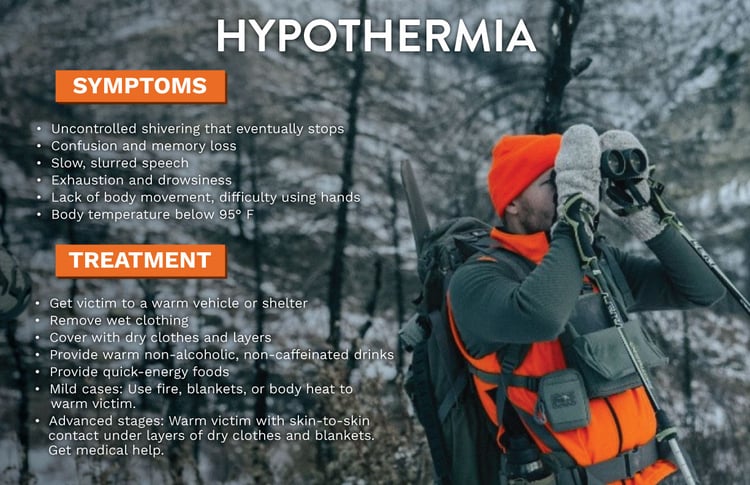
Symptoms of Hypothermia
Your ability to recognize hypothermia will up the odds of recovery and survival. Watch for these symptoms of hypothermia as noted by Hunter’s Ed:
- Uncontrolled shivering, which ceases as hypothermia progresses
- Confusion, irrational behavior, memory loss
- Slow, slurred speech
- Exhaustion and drowsiness
- Lack of body movement and difficulty using hands
- Body temperature below 95°F
Act immediately if you notice any of these behaviors. Fast action can save your own life or someone else’s.
How To Treat Hypothermia
- Get the person to a warm vehicle or shelter if possible.
- Remove wet clothing and replace with dry clothes and other protective covering.
- For mild cases, use fire, blankets, or another person’s body heat to warm the victim.
- Provide warm non-alcoholic, non-caffeinated drinks and quick-energy food like chocolate, peanuts, or raisins to help produce body heat.
- In more advanced stages, rewarm the victim slowly by using skin-to-skin contact under layers of dry clothes and blankets. If available, place canteens of hot water insulated with socks or towels on the groin, armpits, and sides of the neck of the victim. Contact emergency medical personnel to evacuate the victim to a hospital.
Frostbite
Frostbite is a cold-induced injury where tissues—typically on ears, nose, toes, fingers, chin, or cheeks—freeze and may become permanently damaged. Poor blood circulation, low blood pressure, damp or soaked clothing, or simply not wearing the correct clothing, all increase the risk of frostbite.
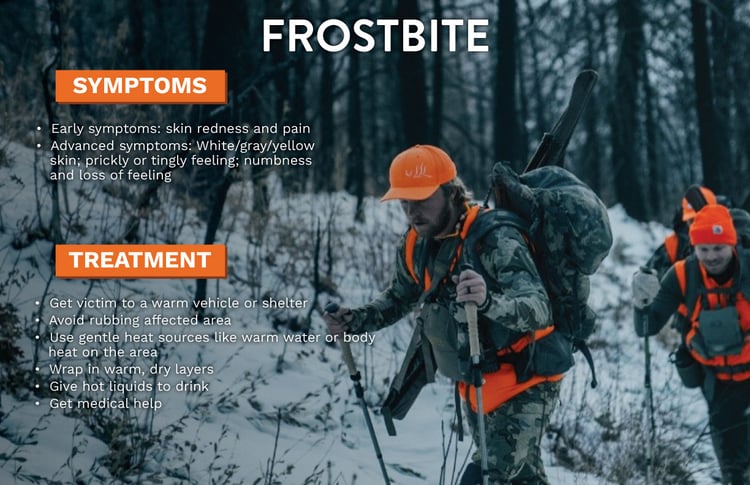
Symptoms of Frostbite
- Early symptoms: skin redness and pain
- Advanced symptoms: White/gray/yellow skin; prickly or tingly feeling; numbness and loss of feeling
How to Treat Frostbite
- Get the person to a warm vehicle or shelter if possible.
- Use only gentle heat sources on the affected area, such as warm water or body heat.
- Avoid rubbing the affected area, as it can damage tissue.
- Wrap the area in warm, dry clothing.
- Give the person hot liquids to drink.
- Quickly get them medical help.
How to Layer for Cold Weather Hunting
When you’re warm and comfortable in the field, you can endure the cold longer and concentrate better on your hunt. The best way to stay warm hunting is to keep dry and wear layers. A layering system of base, mid layer, and outer shell—and using the right materials for each—will help you stay dry and toasty. These are my recommendations for the best way to layer from head to toe:
Head
- Wool beanie for very cold weather; ball cap to decrease sweating in warmer temps
- Neck gaiter
Core
- Base layer for hunting: merino wool
- Mid layer for hunting: cotton
- Outer layer for hunting: polyester, Cordura, or nylon
- Winter hunting coat: feather-filled down or super down (if you’re not moving a lot)
Hands
- Base layer: merino wool
- Outer shell: thick, insulated gloves
Legs
- Base layer: merino wool
- Outer shell: Cordura or polyester
- Leg gaiters to keep legs warm and snow out of boots
- Insulated layer: puffy down (if you’re not moving a lot)
Feet
- One pair of merino wool socks
- Waterproof, insulated winter hunting boots that fit your type of hunt (you’ll want more insulation the less you’re moving)
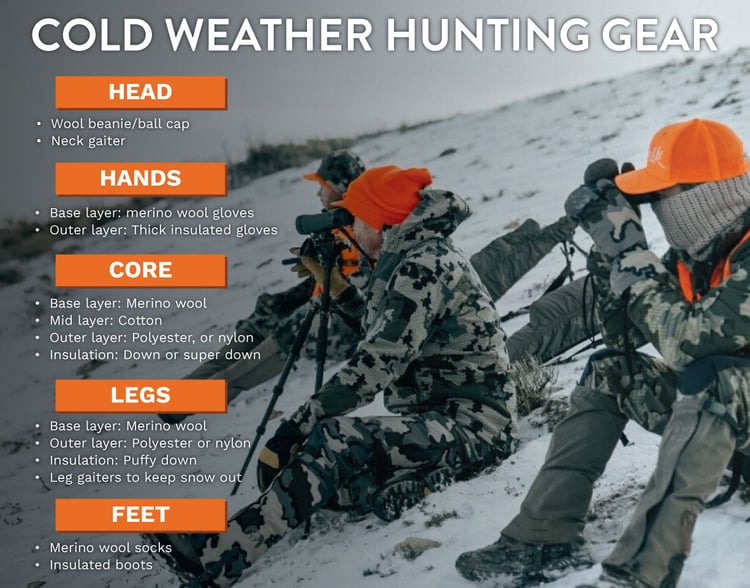
My Picks for Best Cold Weather Hunting Clothes
The location and type of your hunt will help determine what kind of warm hunting clothing will work best for you. If you're looking for recommendations to consider and compare, however, here are some of my top picks to point you in the right direction:
- Best cold weather hunting hat: Kuiu Kenai Beanie or Carhart Knit Cuffed Beanie
- Best cold weather hunting shirts: Kuiu hunting shirts and tops
- Best cold weather hunting jacket: Kuiu Super Down PRO Hooded Jacket
- Best cold weather hunting gloves: Kuiu Northstar Glommit
- Best hunting socks for cold weather: Kuiu ULTRA Merino Over-the-Calf or Carhart Arctic Heavyweight Merino Wool Blend
- Best cold weather hunting boots: Crispi Guide GTX Boot
- Best rubber hunting boots for cold weather: LaCrosse AlphaBurley Pro 1,600
- Cold weather clothing for the Eastern whitetail hunter: SITKA Gear
Cold Weather Hunting Gear
Besides layers of good-quality clothing, there are a few other tricks you can deploy and gear you can buy to stay warm while hunting. The type of hunting you do—whether a stalk hunt traversing vast terrain or sitting still in a tree stand—will help determine which hunting gear works best to stay warm. Here are some options to consider:
- Disposable hand and foot warmers
- Battery-operated electric heated socks and gloves
- Heated vest
- Body insulator (good for still hunting)
- Heater body suit (great for staying warm while treestand hunting)
- Heater Hunting Buddy portable heater (best way to stay warm in a hunting blind)
Frigid temperatures don’t have to put a freeze on your enjoyment or success during cold-weather hunts. You can stay comfortable and stay afield longer by keeping dry, dressing in proper layers, and packing the right winter hunting gear. And if you do run into trouble, knowing how to recognize and treat the symptoms of hypothermia and frostbite can help save your own life or others'. So, stay safe out there, hunt smart, and good luck filling your late-season tags!
Click below to find more of Sky's favorite hunting gear and brands for eastern and western hunters that are applicable year-round.
© Redmond Hunt 2022. All rights reserved.


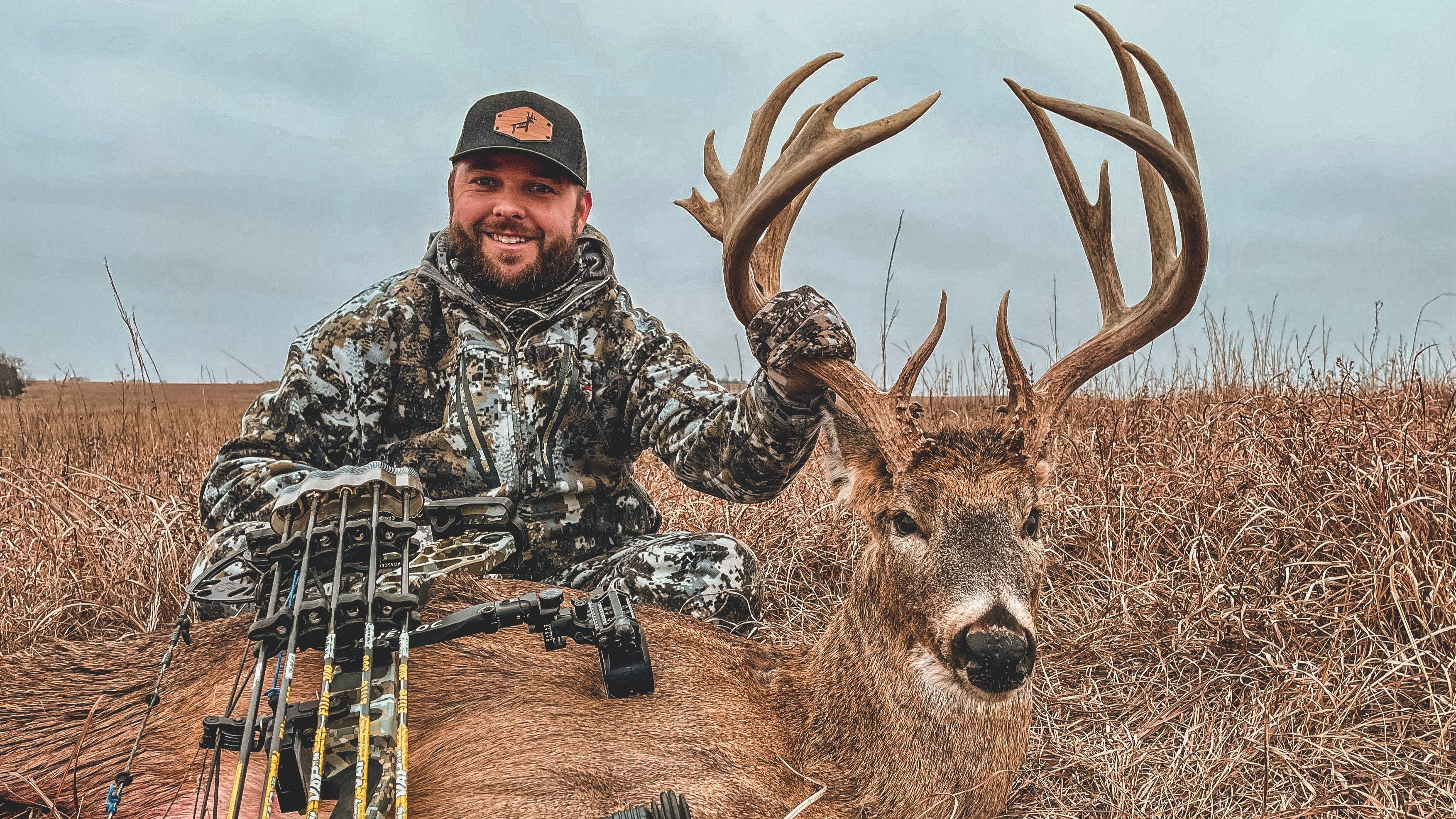
.jpg)
